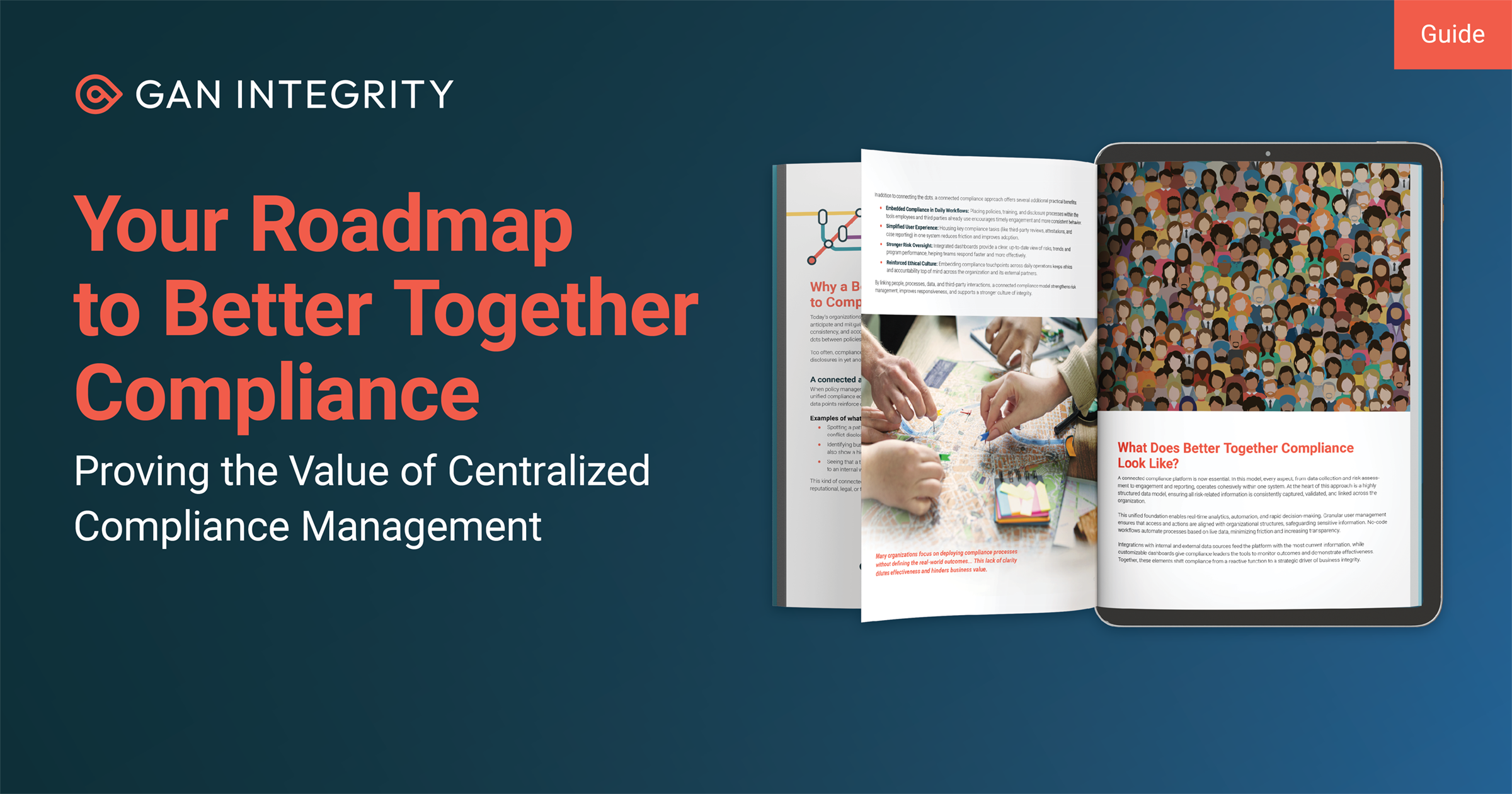While many compliance teams operate in an office environment with easy access to tools and technology, heavy industries like mining, oil and gas, manufacturing, shipbuilding, construction, and more, have unique compliance challenges. These industries are the backbone of the global economy, but their unique work environments look different when it comes to keeping everyone safe, engaged, and in line with ever-changing regulations.
This blog explores why connected compliance is a must-have for heavy industries, the best practices you should know, and how you can make compliance work for your teams, no matter where they are.
The Compliance Challenge: Out of the Office, Into the Field
Unlike office-based sectors, most of the workforce in heavy industries is out in the field; on rigs, in plants, or scattered across remote sites. Many of these team members do not have easy or consistent access to a laptop and internet access. Instead, they’re dealing with unpredictable schedules, tough (and sometimes hazardous) working conditions, and limited face-to-face interaction with management or HR.
This physical dispersion makes it tough to ensure every employee is consistently engaged with critical safety training, compliance updates, and evolving protocols. When you add in language barriers, cultural differences, and the sheer scale of some operations, it’s easy for things to slip through the cracks.
The Risks of Disconnected Compliance
What happens when compliance falls by the wayside? The risks are real:
- Safety lapses: Workers may miss out on new safety protocols or forget to report hazards.
- Regulatory violations: Inconsistent training or documentation can lead to fines or shutdowns.
- Lower engagement: Employees who feel disconnected are less likely to speak up about issues.
- Higher turnover: Poor communication and lack of support can drive people away.
And let’s not forget the importance of a strong “speak-up” culture. In isolated environments, traditional whistleblowing channels can feel intimidating or inaccessible. If workers can’t easily and confidentially report concerns, you might miss early warning signs of misconduct or unsafe practices—opening the door to legal, financial, and reputational harm.
The Solution: Connected Compliance
So how do you bridge the gap between the office and the field? The answer is connected compliance, a seamless, integrated approach that uses mobile tools, in-field solutions, and connected worker technologies to keep everyone in the loop.
What Does Connected Compliance Look Like?
Connected compliance is all about meeting your workers where they are. It means providing intuitive, always-accessible systems for training, policy updates, and anonymous reporting. When you empower every worker, regardless of location or device, to stay informed and engaged, you build a culture of safety, trust, and accountability.
Building a Cohesive Compliance Experience Across Locations
Heavy industries often operate across multiple countries, regions, and even continents. That means compliance teams have to juggle a patchwork of local, national, and international regulations. Safety, training, whistleblowing compliance, and other risk areas can all have their own requirements.
Best Practice: Set the Highest Bar
When regulatory requirements get too complex, a proven best practice is to identify the country or jurisdiction with the strictest compliance standards and adopt those across your organization.
By using the toughest rules as your baseline, you ensure you’re not just meeting, but exceeding, compliance obligations everywhere you operate. This approach:
- Simplifies training and monitoring where everyone gets the same message, no matter where they are.
- Reduces risk of oversight with fewer gaps and fewer surprises.
- Builds a unified culture where safety and compliance become part of your company DNA.
When to Use a Risk-Based Approach
Of course, if you can clearly differentiate between regulatory expectations in each location, a risk-based approach can be more efficient. Prioritize resources based on exposure and impact, focusing on the areas where the risks, and potential consequences, are highest. This lets you allocate time and money where it matters most, without overburdening teams in low-risk areas.
Embracing In-Field Compliance Tools
Not everyone in heavy industry has access to a computer or even reliable internet. Construction crews, field techs, warehouse staff, they need compliance tools that work where they do. This is where in-field solutions shine.
Practical Tools for Real-World Work
In-field compliance tools bridge the gap between digital oversight and hands-on work environments. They empower employees to stay informed and engaged, without relying on traditional desktop access. Here are some examples that organizations can adopt:
- Hotline phone numbers: Set up for anonymous safety or compliance reporting, available 24/7.
- QR codes: Placed on equipment or in break rooms, linking to training videos, safety checklists, or policy documents.
- Mobile whistleblower apps: For incident reporting, safety audits, or quick training refreshers—right from a smartphone.
- Wearable devices: Hard hats or vests that provide real-time safety alerts or track compliance with safety protocols.
- Toolbox talks via SMS or automated calls: Short, targeted safety briefings delivered right to workers’ phones.
- Physical suggestion boxes: For sites with limited connectivity, old-school paper still works for collecting feedback.
By rolling out these tools, you make sure everyone, regardless of their tech access, gets the resources they need to work safely and stay compliant. Plus, it builds trust and accountability across your team.
Why Centralized, Connected Compliance is a Game-Changer
Today’s compliance landscape is more complex than ever. You’re managing everything from whistleblowing and training to policy management, conflicts of interest, and third-party risk. Trying to do all this with spreadsheets, emails, or disconnected systems? That’s a recipe for duplicated work, inconsistent data, and missed risks.
The Power of Centralization
Connected compliance platforms bring all your compliance programs and risk management activities together in one place. This means you can:
- Streamline processes: Automate routine tasks and reduce manual errors.
- Keep everything up to date: Policies, training, disclosures, and incident reports are always accessible.
- Simplify audits and reporting: Everything you need is at your fingertips.
- Enhance collaboration: Real-time data sharing and integrated risk assessments help teams work together.
- Spot patterns and respond fast: With all your data in one place, you can identify trends and act before small issues become big problems.
These platforms are also designed to be user-friendly, with intuitive dashboards, customizable workflows, and built-in communication tools. That means higher adoption rates, better awareness, and the flexibility to roll out new campaigns or training as needed.
Making Compliance Engaging
With the right tools and approach, you can make it more engaging for everyone. Here’s how:
- Keep it simple: Use plain language, visuals, and short videos instead of dense documents.
- Make it mobile: Training and reporting should be easy to access from any device.
- Encourage feedback: Let workers suggest improvements or flag issues—anonymously if needed.
- Celebrate wins: Recognize teams or individuals who go above and beyond on safety and compliance.
When compliance feels like a team effort, people are more likely to buy in, and that leads to better results across the board.
The Bottom Line: Building a Safer Workplace
Investing in connected compliance technology isn’t just about ticking boxes—it’s about building a safer, more engaged, and more resilient workforce. In heavy industries, where the risks are high and the stakes even higher, that’s not just a best practice, it’s a necessity.
By meeting your teams where they are, embracing in-field tools, and centralizing your compliance efforts, you can turn compliance from a headache into a strategic advantage. You’ll cut costs, reduce legal risk, and support continuous improvement across your business.
So, if you want your teams to stay safe, engaged, and compliant—no matter where they are—now’s the time to embrace connected compliance. Your workforce (and your bottom line) will thank you.
Ready to make compliance work for your field teams? Explore our Connected Compliance Guide and build a culture of safety, trust, and accountability that goes wherever your teams do.

Hannah Tichansky is the Content and Social Media Manager at GAN Integrity. Hannah holds over 13 years of writing and marketing experience, with 8 years of specialization in the risk management, supply chain, and ESG industries. Hannah holds an MA from Monmouth University and a Certificate in Product Marketing from Cornell University.
